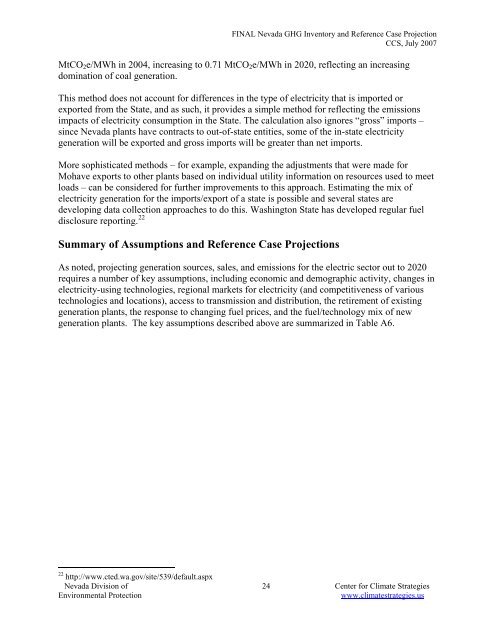Nevada Greenhouse Gas Inventory and Reference Case Projections
Nevada Greenhouse Gas Inventory and Reference Case Projections
Nevada Greenhouse Gas Inventory and Reference Case Projections
You also want an ePaper? Increase the reach of your titles
YUMPU automatically turns print PDFs into web optimized ePapers that Google loves.
FINAL <strong>Nevada</strong> GHG <strong>Inventory</strong> <strong>and</strong> <strong>Reference</strong> <strong>Case</strong> Projection<br />
CCS, July 2007<br />
MtCO 2 e/MWh in 2004, increasing to 0.71 MtCO 2 e/MWh in 2020, reflecting an increasing<br />
domination of coal generation.<br />
This method does not account for differences in the type of electricity that is imported or<br />
exported from the State, <strong>and</strong> as such, it provides a simple method for reflecting the emissions<br />
impacts of electricity consumption in the State. The calculation also ignores “gross” imports –<br />
since <strong>Nevada</strong> plants have contracts to out-of-state entities, some of the in-state electricity<br />
generation will be exported <strong>and</strong> gross imports will be greater than net imports.<br />
More sophisticated methods – for example, exp<strong>and</strong>ing the adjustments that were made for<br />
Mohave exports to other plants based on individual utility information on resources used to meet<br />
loads – can be considered for further improvements to this approach. Estimating the mix of<br />
electricity generation for the imports/export of a state is possible <strong>and</strong> several states are<br />
developing data collection approaches to do this. Washington State has developed regular fuel<br />
disclosure reporting. 22<br />
Summary of Assumptions <strong>and</strong> <strong>Reference</strong> <strong>Case</strong> <strong>Projections</strong><br />
As noted, projecting generation sources, sales, <strong>and</strong> emissions for the electric sector out to 2020<br />
requires a number of key assumptions, including economic <strong>and</strong> demographic activity, changes in<br />
electricity-using technologies, regional markets for electricity (<strong>and</strong> competitiveness of various<br />
technologies <strong>and</strong> locations), access to transmission <strong>and</strong> distribution, the retirement of existing<br />
generation plants, the response to changing fuel prices, <strong>and</strong> the fuel/technology mix of new<br />
generation plants. The key assumptions described above are summarized in Table A6.<br />
22 http://www.cted.wa.gov/site/539/default.aspx<br />
<strong>Nevada</strong> Division of 24 Center for Climate Strategies<br />
Environmental Protection<br />
www.climatestrategies.us
















